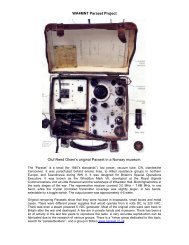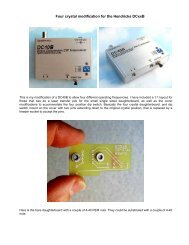Small Magnetic Loop Antenna Project - QRPBuilder.com
Small Magnetic Loop Antenna Project - QRPBuilder.com
Small Magnetic Loop Antenna Project - QRPBuilder.com
You also want an ePaper? Increase the reach of your titles
YUMPU automatically turns print PDFs into web optimized ePapers that Google loves.
An Overview of the Underestimated <strong>Magnetic</strong> <strong>Loop</strong> HF <strong>Antenna</strong><br />
It seems one of the best kept secrets in the amateur radio <strong>com</strong>munity is how well a small<br />
diminutive magnetic loop antenna can really perform in practice <strong>com</strong>pared with large<br />
traditional HF antennas. The objective of this article is to disseminate some practical<br />
information about successful homebrew loop construction and to enumerate the loop’s key<br />
distinguishing characteristics and unique features. A magnetic loop antenna can very<br />
conveniently be ac<strong>com</strong>modated on a table top, hidden in an attic / roof loft, an outdoor<br />
porch, patio balcony of a high-rise apartment, rooftop, or any other space constrained site.<br />
A small but efficacious HF antenna for restricted space sites is the highly sort after Holy<br />
Grail of many an amateur radio enthusiast. This quest and interest is particularly strong<br />
from amateurs having to face the prospect of giving up their much loved hobby as they<br />
move from suburban residential lots into smaller restricted space retirement villages and<br />
other <strong>com</strong>munities that have strict rules against erecting elevated antenna structures. In<br />
spite of these imposed restrictions amateurs do have a practical and viable alternative<br />
means to actively continue the hobby using a covert in-door or portable outdoor and<br />
sympathetically placed small magnetic loop. This paper discusses how such diminutive<br />
antennas can provide an entirely workable <strong>com</strong>promise that enable keen amateurs to keep<br />
operating their HF station without any need for their previous tall towers and favourite<br />
beam antennas or unwieldy G5RV or long wire. The practical difference in station signal<br />
strength at worst will be only an S-point or two.<br />
Anyone making a cursory investigation into the subject of magnetic loop antennas using<br />
the Google internet search engine will readily find an overwhelming and perplexing<br />
abundance of material. This article will assist readers in making sense of the wide diversity<br />
of often times conflicting information with a view to facilitate the assimilation of the<br />
important essence of practical knowledge required to make an electrically-small loop work<br />
to its full potential and yield very good on-air performance.<br />
A few facts:<br />
A properly designed and constructed small loop of nominal 1m diameter will outperform<br />
any antenna type except a tri-band beam on the 10m/15m/20m bands, and will be within an<br />
S-point (6dB) or so of an optimised mono-band 3-element beam that’s mounted at an<br />
appropriate height above ground.<br />
<strong>Magnetic</strong> loops really <strong>com</strong>e into their own on the higher HF bands from say 40m through<br />
to 10m; oftentimes with absolutely stunning performance rivalling the best conventional<br />
antennas. Easily field deployable and fixed site tuned loops have been the routine antenna<br />
of choice for many years in professional defence, military, diplomatic, and shipboard HF<br />
<strong>com</strong>munication links where robust and reliable general coverage radio <strong>com</strong>munication is<br />
deemed mandatory. On 80m and 160m top-band the performance of a small loop antenna<br />
generally exceeds that achievable from a horizontal dipole, particularly one deployed at<br />
sub-optimal height above ground. This is a <strong>com</strong>mon site limitation for any HF antenna.<br />
So where’s the catch; if the small loop is such a good antenna why doesn’t everyone have<br />
one and dispense with their tall towers? The laws of nature and electromagnetics cannot be<br />
violated and the only unavoidable price one pays for operating with an electrically-small<br />
antenna is narrow bandwidth. Narrow instantaneous bandwidth rather than poor efficiency<br />
is the fundamental limiting factor trade-off with small loops.<br />
1





